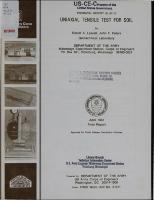Please use this identifier to cite or link to this item:
https://hdl.handle.net/11681/12738Full metadata record
| DC Field | Value | Language |
|---|---|---|
| dc.contributor.author | Leavell, Daniel A. | - |
| dc.contributor.author | Peters, John F. | - |
| dc.date.accessioned | 2016-07-06T14:27:41Z | - |
| dc.date.available | 2016-07-06T14:27:41Z | - |
| dc.date.issued | 1987-04 | - |
| dc.identifier.uri | http://hdl.handle.net/11681/12738 | - |
| dc.description | Technical Report | - |
| dc.description | Abstract: The tensile strength of soil is generally considered small for engineering applications. Yet there are a number of applications where even a small amount of tensile strength can have significant influence on computational results and actual structure performance. For example, the tensile strengths of clays are significant in problems involving low mean normal stresses. Motivation for studying tensile strength comes indirectly from the study of partially saturated soils, as the tensile strength is presumably derived from the suction potential of the soil. This report describes an apparatus for measuring strength of soil in direct tension. Data are presented for compacted Vicksburg silty clay for uniaxial tension and unconsolidated-undrained (Q) compression tests with a view toward proposing criteria to relate tensile and compressive strengths for partially saturated materials. The primary advantage of the apparatus is its ability to apply a uniaxial load through precisely aligned end-grips, which are restricted from rotations about the long axis of the specimen. This design is in contrast to tensile tests for rock and concrete that avoid applying moments to specimen ends by attaching the end-grips to a flexible pulling mechanism. A flexible loading mechanism was viewed as unsuitable for brittle low-strength compacted soils because of difficulties in achieving precise loading alignment. Precise alignment for the tensile device is achieved by mounting one of the end-grips on a commercially available slide table that restricts movement to one direction. The testing program for compacted Vicksburg silty clay consisted of over 40 tensile tests on specimens having different molding water contents and compaction efforts. Other tests included Q, compaction, Atterberg limits, and suction potential. Comparisons were also made with tensile strengths previously determined for Vicksburg silty clay using the double punch, split cylinder, and hollow cylinder tests. A major finding of the laboratory investigation was that of all methods used to determine tensile properties, the highest strength and stiffness was obtained from the direct tensile device. Strengths obtained from the hollow cylinder test were comparable to the direct tension test provided that the maximum stress at the interior wall of the cylinder was used as the basis of comparison. Research by other investigators are cited that show similar trends. A model is proposed that relates the strength derived from capillary tension to a fracture law. Using Griffith theory, the tensile strength is related to the cohesion intercept obtained from Q tests. The predicted correlation between compressive and tensile strengths was supported by the experimental data. Further, the strengths from compression and tension tests were correlated with water content relative to optimum, and dry density; however strength did not correlate with suction potential. If similar results are found for other clays, it would appear that the tensile strength of unsaturated soil cannot be viewed as a special case of the effective stress law in which the suction potential is simply treated as a negative pore pressure. | - |
| dc.publisher | Geotechnical Laboratory (U.S.) | - |
| dc.publisher | Engineer Research and Development Center (U.S.) | - |
| dc.relation | http://acwc.sdp.sirsi.net/client/en_US/search/asset/1026980 | - |
| dc.relation.ispartofseries | Technical report (U.S. Army Engineer Waterways Experiment Station) ; GL-87-10. | - |
| dc.rights | Approved for public release; distribution is unlimited. | - |
| dc.source | This Digital Resource was created from scans of the Print Resource | - |
| dc.subject | Brittle fracture | - |
| dc.subject | Partially saturated soils | - |
| dc.subject | Soils | - |
| dc.subject | Soil mechanics | - |
| dc.subject | Compacted soils | - |
| dc.subject | Q Tests (soils) | - |
| dc.subject | Critical state theory | - |
| dc.subject | Shear strength | - |
| dc.subject | Soil suction | - |
| dc.subject | Tensile strength | - |
| dc.subject | Triaxial test | - |
| dc.subject | Unconsolidated-undrained test | - |
| dc.title | Uniaxial tensile test for soil | - |
| dc.type | Report | en_US |
| Appears in Collections: | Technical Report | |
Files in This Item:
| File | Description | Size | Format | |
|---|---|---|---|---|
| TR-GL-87-10.pdf | 17.09 MB | Adobe PDF |  View/Open |